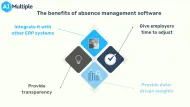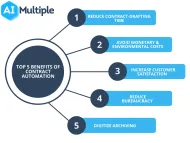Top 5 Benefits of Employee Offboarding Automation in 2024
According to the 2021 Bureau of Labor Statistics report, the annual employee turnover in 2020 was 57.3%. One way to look at that statistic is that companies are conducting an increasing amount of employee offboarding processes.
The employee offboarding process is automatable. Yet, only 5% have fully automated it.
This article will explore the top 5 benefits companies can gain from automating their offboarding process.
1. Systematize your offboarding process
A prerequisite to automation is a thorough understanding of how a process works. Process intelligence tools, such as process mining or process mapping, help you get an as-is understanding of the current state of your process.
From there on, you can use different automation tools to systematically automate your offboarding process on a rule-based basis. The benefit of understanding how your processes currently work and laying the groundwork for a step-by-step process for the software bots to follow is that your company will have a clearly-defined onboarding process for both the employee and the employer to follow.
2. Secure confidential information
Outgoing employees taking the company’s confidential information with them is one way that intellectual property (IP) theft happens. One way to reduce its likelihood is to restrict the outgoing employee’s access to the information.
Companies today use multiple business applications, with employees naturally having login credentials to do their jobs. Making sure that said credentials are taken back from an outgoing employee is key to keeping the data secured.
The challenge is ensuring that access to everything is blocked.
An offboarding software can be programmed to restrict access to all ERP applications, email accounts, databases, and more in a rule-based manner.
3. Archive employee documents efficiently
The outgoing employee’s replacement should have access to what his/her predecessor had been working on.
Let’s say a new accountant is replacing the old one. The former needs to, for instance, have access to the quarterly reports the latter had been preparing prior to his/her offboarding.
Archiving all the relevant documents in one location to ensure operational efficiency is key for the new employee’s onboarding process.
An RPA-powered offboarding software can be programmed, via screen-scraping or recording, to archive all necessary documents in one convenient location should an employee decide to leave the company. This will make it easier that there would be no missing material for the new employee to work with.
4. Communicate the departure
To ensure that the to-be vacant position is filled as soon as possible for business continuity, the subject matter should be communicated promptly and clearly to all relevant parties.
For instance, if the head of your IT department is leaving, the recruitment department should be notified of that at least two weeks in advance in order to start looking for a replacement. And the key to that is communicating the matter to the recruitment department.
Or let’s say an employee has been let go for violating a company policy. That matter should be transparently shared with all current employees to let them know what rule had exactly been violated, and the consequences.
Offboarding software applications have in-built messaging capabilities that allow for communications, specific to this subject matter, to efficiently and transparently take place.
5. Eliminate guesswork
Especially if a company has employees on different contracts – full-time, part-time, freelancer, etc. – it might be difficult to calculate their individual compensation prior to offboarding.
Offboarding software can be linked by API to exchange employee information with other applications to establish:
- The department they worked with,
- Their role,
- Contract type,
- Date of the last invoice,
- Severance package calculation, and more, in a rule-based and accurate manner with minimal manual intervention.
For more on automation
To learn more about other use cases of automation in the workplace, read:
- Top 5 RPA Use Cases & Applications in Accounting
- Top 5 Benefits of Contract Automation
- 4 Ways to Improve Your Business with Self-Service Automation
If you believe your business would benefit from adopting an automation solution, we have data-driven lists of vendors prepared for various use cases.
We can help you choose the right tool for your business:

Cem has been the principal analyst at AIMultiple since 2017. AIMultiple informs hundreds of thousands of businesses (as per similarWeb) including 60% of Fortune 500 every month.
Cem's work has been cited by leading global publications including Business Insider, Forbes, Washington Post, global firms like Deloitte, HPE, NGOs like World Economic Forum and supranational organizations like European Commission. You can see more reputable companies and media that referenced AIMultiple.
Throughout his career, Cem served as a tech consultant, tech buyer and tech entrepreneur. He advised businesses on their enterprise software, automation, cloud, AI / ML and other technology related decisions at McKinsey & Company and Altman Solon for more than a decade. He also published a McKinsey report on digitalization.
He led technology strategy and procurement of a telco while reporting to the CEO. He has also led commercial growth of deep tech company Hypatos that reached a 7 digit annual recurring revenue and a 9 digit valuation from 0 within 2 years. Cem's work in Hypatos was covered by leading technology publications like TechCrunch and Business Insider.
Cem regularly speaks at international technology conferences. He graduated from Bogazici University as a computer engineer and holds an MBA from Columbia Business School.
To stay up-to-date on B2B tech & accelerate your enterprise:
Follow on

Comments
Your email address will not be published. All fields are required.